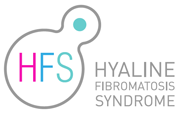Molecular mechanisms
HFS is an autosomal inherited recessive disorder. The affected gene has been localized at the chromosome position 4q21 (1) and found to be the cmg2 (Capillary Morphogenesis Gene 2) gene (2,3). There is no evidence to support genetic heterogeneity in HFS, with a mutation on a second gene, since all analyzed families so far showed linkage and/or mutation involving CMG2 as the causative agent.
This gene encodes for the CMG2 protein, which is localized at the cell surface and potentially acts as a receptor for extracellular matrix proteins (4) (as well as for one of the anthrax toxin component) (5).
The CMG2 protein is a 489 amino-acids type I transmembrane glycoprotein composed of 4 different domains (6):
- a Von Willebrand factor type A (vWA) domain: allowing interaction with other proteins outside the cell (ligand binding),
- an Ig-like domain (no function known),
- a transmembrane domain: anchoring the protein at the cell membrane,
- a cytoplasmic tail: undergoing modifications upon activation and allowing interaction with other protein partners inside the cell.
Although the precise physiological function of CMG2 is not yet elucidated, some studies showed that:
- CMG2 is involved in capillary morphogenesis (4),
- CMG2 plays a key role in anthrax infection as a route of entry into the cell for the toxin (5),
- The CMG2 analog protein determines the mitotic orientation during embryogenesis in zebrafish (7),
- CMG2-deficient mice did not display any apparent symptoms but female have a fibrotic uterus (8,9).
Some 40 different mutations have been identified on the cmg2 gene.
So far, mutations can be classified into four major classes according to different molecular consequences affecting the CMG2 protein (6):
- Class I: missense mutations in the vWA domain that do not affect plasma membrane targeting but impair ligand binding (10).
- Class II: all other missense mutations in exons 1 to 11 (coding for the extracellular part of the protein) that affect the folding/stability of either the vWA domain or the Ig-like domain (11,12).
- Class III: all frameshift mutations that lead to a premature stop codon as well as potential splicing defect mutations. These mutations either affect the mRNA stability or lead to change in protein sequence and size (13).
- Class IV: missense mutations in the cytoplasmic tail of CMG2. These mutations are not expected to affect the mRNA level, nor the plasma membrane targeting of the protein. These mutations might affect CMG2 function by modifying interactions with partners or altering post-translational modifications.
As CMG2 mutations could be classified into 4 different classes due to their different molecular consequences, these observations highlight the importance of in-depth genotype–phenotype analysis for potential personalized therapeutic treatment (6).
(1) Rahman et al, 2002 (2) Dowling et al, 2003 (3) Hanks et al, 2003 (4) Bell et al, 2001 (5) Scobie et al, 2003 (6) Deuquet et al, 2011 (review) (7) Castanon et al, 2013 (8) Reeves et al, 2012 (9) Peters et al, 2012 (10) Lindvall et al, 2008 (11) Deuquet et al, 2009 (12) Deuquet et al, 2011 (13) Yan et al, 2013 (submitted and reviewed publication)




